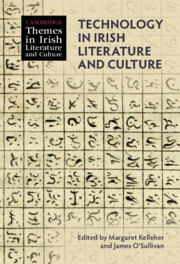Book contents
- Technology in Irish Literature and Culture
- Cambridge Themes in Irish Literature and Culture
- Technology in Irish Literature and Culture
- Copyright page
- Epigraph
- Contents
- Contributors
- Cambridge Themes in Irish Literature and Culture
- Acknowledgements
- Introduction
- Part I Genealogies
- Part II Infrastructures
- Part III Invention
- Chapter 8 Technology, Writing, and Place in Medieval Irish Literature
- Chapter 9 The Critique of Sola Scriptura in A Tale of a Tub and STEM in Gulliver’s Travels
- Chapter 10 Technology and Irish Modernism
- Chapter 11 W. B. Yeats, the Revival, and Scientific Invention
- Chapter 12 James Joyce, Irish Modernism, and Watch Technology
- Chapter 13 Technology, Terminology, and the Irish Language, Past and Present
- Part IV The Digital
- Index
- References
Chapter 12 - James Joyce, Irish Modernism, and Watch Technology
from Part III - Invention
Published online by Cambridge University Press: 19 January 2023
- Technology in Irish Literature and Culture
- Cambridge Themes in Irish Literature and Culture
- Technology in Irish Literature and Culture
- Copyright page
- Epigraph
- Contents
- Contributors
- Cambridge Themes in Irish Literature and Culture
- Acknowledgements
- Introduction
- Part I Genealogies
- Part II Infrastructures
- Part III Invention
- Chapter 8 Technology, Writing, and Place in Medieval Irish Literature
- Chapter 9 The Critique of Sola Scriptura in A Tale of a Tub and STEM in Gulliver’s Travels
- Chapter 10 Technology and Irish Modernism
- Chapter 11 W. B. Yeats, the Revival, and Scientific Invention
- Chapter 12 James Joyce, Irish Modernism, and Watch Technology
- Chapter 13 Technology, Terminology, and the Irish Language, Past and Present
- Part IV The Digital
- Index
- References
Summary
Across his career, as the previous work of this chapter’s author and that of other critics such as Andrzej Duszenko, M. Keith Booker, David Ben-Merre, Jeffrey Drouin, and Ruben Borg has shown, James Joyce frequently included reflections on a changing landscape of time in response to Einstein’s ‘new physics’. However, while there has been important recent research touching on this topic, including the author’s wider survey of work in modernist studies, no critic has yet fully centred the watch as a technological index of Joyce’s attitudes to time. In this essay, three specific examples of Joyce’s concern with watch technology are looked at, located in the relationship of timepiece and character; firstly, Bertha’s wristwatch in Joyce’s play Exiles (1918), followed by Bloom’s pocket watch in Ulysses (1922) and, finally, HCE’s timepiece in Finnegans Wake. Each of these watches evidence Joyce’s complex feelings about connections between embodiment, sexuality, and technology.
- Type
- Chapter
- Information
- Technology in Irish Literature and Culture , pp. 201 - 216Publisher: Cambridge University PressPrint publication year: 2023



